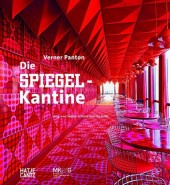 Neuerscheinungen 2012Stand: 2020-01-07 |
Schnellsuche
ISBN/Stichwort/Autor
|
Herderstraße 10
10625 Berlin
Tel.: 030 315 714 16
Fax 030 315 714 14
info@buchspektrum.de |

Ina Grätz, Sabine Schulze
(Beteiligte)
Verner Panton ´Die Spiegel-Kantine´
Hrsg.: Museum für Kunst und Gewerbe Hamburg
Hrsg. Sabine Schulze, Ina Grätz
2012. 112 S. m. 104 Farbabb. 247.0 mm
Verlag/Jahr: HATJE CANTZ VERLAG 2012
ISBN: 3-7757-3321-3 (3775733213)
Neue ISBN: 978-3-7757-3321-2 (9783775733212)
Preis und Lieferzeit: Bitte klicken
Verner Pantons Gesamtkunstwerk: die SPIEGEL-Kantine, eine Orgie in Orange, Rot und Lila
1969 bezieht der SPIEGEL Verlag in Hamburg ein anderes Domizil; das neue Verlagshaus erhält eine individuelle Inneneinrichtung: Der Däne Verner Panton (1926 1998) gestaltet das Gebäude um und weist jedem Stockwerk eine andere knallige Farbe zu. Seine dreidimensionalen Rauminstallationen und deren psychedelische Wirkung treffen genau den Zeitgeschmack. Leider empfinden kommende Journalisten-Generationen anders und so wird Pantons Einrichtung in der Folge nach und nach rückgebaut. Nur die Kantine bleibt in ihrer ganzen Pracht erhalten, sie wird auf Betreiben einer Bürgerinitiative unter Denkmalschutz gestellt und ist ab 2012 im Hamburger Museum für Kunst und Gewerbe zu sehen. Dort wird jedoch nur der orangefarbene Speisesaal aufgebaut, der rote und der violette Speiseraum sowie die Snackbar wandern ins Depot . Die Publikation führt nochmals das ganze farbenfrohe Ensemble aus Möbeln, Lampen, Vorhängen, Wand- und Deckenbekleidung vor Augen ein einzigartiges Gesamtkunstwerk.
In 1969 the SPIEGEL publishers moved into a new space in Hamburg, and the company had it decorated to its specifications. The Danish designer Verner Panton (1926-1998) redesigned the building, assigning a bright color to each floor. His three-dimensional installation and its psychedelic effects were precisely in step with the times. Unfortunately, later generations of journalists felt differently about it, and so Pantons interiors were gradually removed, bit by bit. Only the cafeteria remained in all its original splendor; a citizens group succeeded in having it placed under the protection of the historical preservation registry, and as of 2012, it can now be seen at the Hamburg Museum für Kunst und Gewerbe. There, however, only the orange-colored dining hall has been reconstructed; the red one and the violet one are now in the depository, along with the snack bar. This publication documents the cheerfully colorful ensemble of furniture, lamps, curtains, wallpaper, and ceilinga unique and total work of art.


